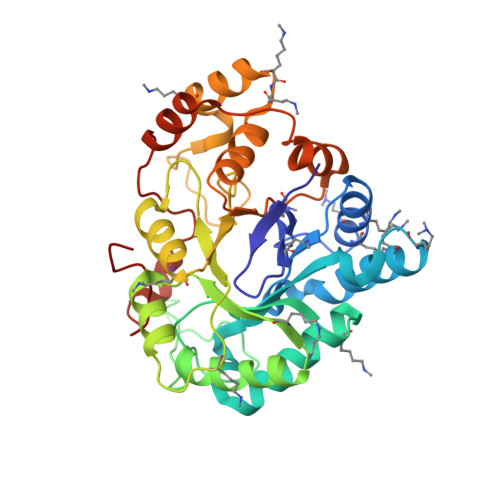Structural analysis of sulindac as an inhibitor of aldose reductase and AKR1B10.
Cousido-Siah, A., Ruiz, F.X., Crespo, I., Porte, S., Mitschler, A., Pares, X., Podjarny, A., Farres, J.(2015) Chem Biol Interact 234: 290-296
- PubMed: 25532697
- DOI: https://doi.org/10.1016/j.cbi.2014.12.018
- Primary Citation of Related Structures:
4WEV - PubMed Abstract:
Aldose reductase (AR, AKR1B1) and AKR1B10 are enzymes implicated in important pathologies (diabetes and cancer) and therefore they have been proposed as suitable targets for drug development. Sulindac is the metabolic precursor of the potent non-steroidal anti-inflammatory drug (NSAID) sulindac sulfide, which suppresses prostaglandin production by inhibition of cyclooxygenases (COX). In addition, sulindac has been found to be one of the NSAIDs with higher antitumoral activity, presumably through COX inhibition. However, sulindac anticancer activity could be partially mediated through COX-independent mechanisms, including the participation of AR and AKR1B10. Previously, it had been shown that sulindac and sulindac sulfone were good AR inhibitors and the structure of the ternary complex with NADP(+) and sulindac was described (PDB ID 3U2C). In this work, we determined the three-dimensional structure of AKR1B10 with sulindac and established structure-activity relationships (SAR) of sulindac and their derivatives with AR and AKR1B10. The difference in the IC50 values for sulindac between AR (0.36 μM) and AKR1B10 (2.7 μM) might be explained by the different positioning and stacking interaction given by Phe122/Phe123, and by the presence of two buried and ordered water molecules in AKR1B10 but not in AR. Moreover, SAR analysis shows that the substitution of the sulfinyl group is structurally allowed in sulindac derivatives. Hence, sulindac and its derivatives emerge as lead compounds for the design of more potent and selective AR and AKR1B10 inhibitors.
Organizational Affiliation:
Department of Integrative Structural Biology, Institut de Génétique et de Biologie Moléculaire et Cellulaire - Centre de Biologie Intégrative, CNRS, INSERM, UdS, 1 rue Laurent Fries, 67404 Illkirch Cedex, France.


















